News Detail
TOA Turns 90; A Retrospective On What Led To The TOA You Know Today
26.Jun.2024
2024 is quite a large milestone for TOA, with this year signifying TOA turning 90! We'd like to think that we've aged like wine, but we may be ever so slightly biased... So as a walk down memory lane, we'll be posting throughout 2024 to document just how far TOA has come!
We're happy to be able to share the last 90 years of history that we've faced as a globally aligned company, and look forward to what the next 90 have in store for TOA!
|
For our first post looking back on the life of TOA, we're looking back on where it all started… The seeds of today's TOA can be found in Kobe, Japan, the same city the TOA's headquarters resides in nearly a century later. Originally TOA Electric Manufacturing Co., Ltd., our company was founded by the Late Nakatani Tsunetaro, TOA's first President. In September of 1934, after having been inspired by a young engineer Tsunetaro met during his travels, TOA would open its doors for the first time and begin manufacturing audio equipment. |
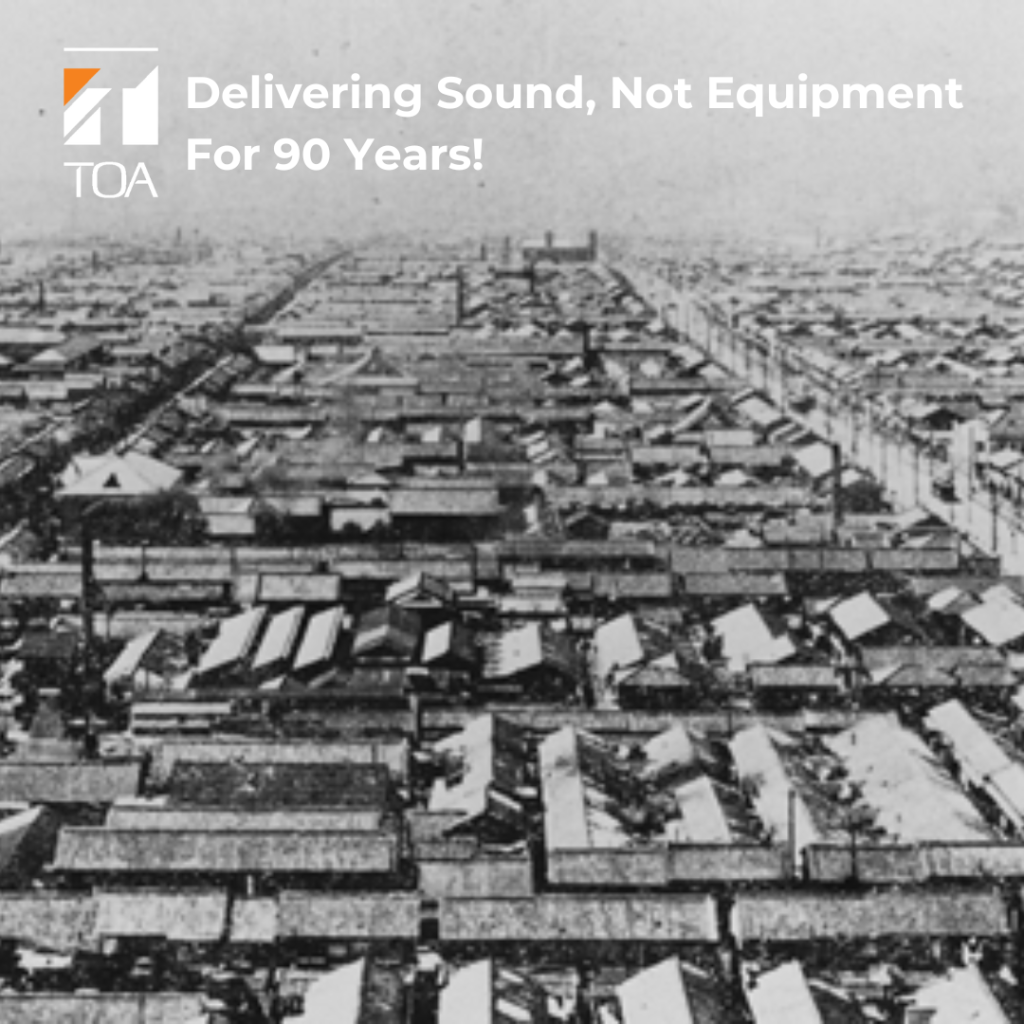 |
|
"Man's happiness lies in the fact that he can do the job he loves with all his might." This was the mantra of the Nakatani Tsunetaro, TOA's founder. And it is this spirit towards delivering quality sound equipment that still propels TOA forward nearly a century later. We strive to constantly iterate, upgrade, and design new equipment, fuelled by the very same passion for delivering quality sound that led to TOA's very creation. We pride ourselves on delivering quality sound for the last 90 years, and look forward to delivering it for the next 90 years as well!" |
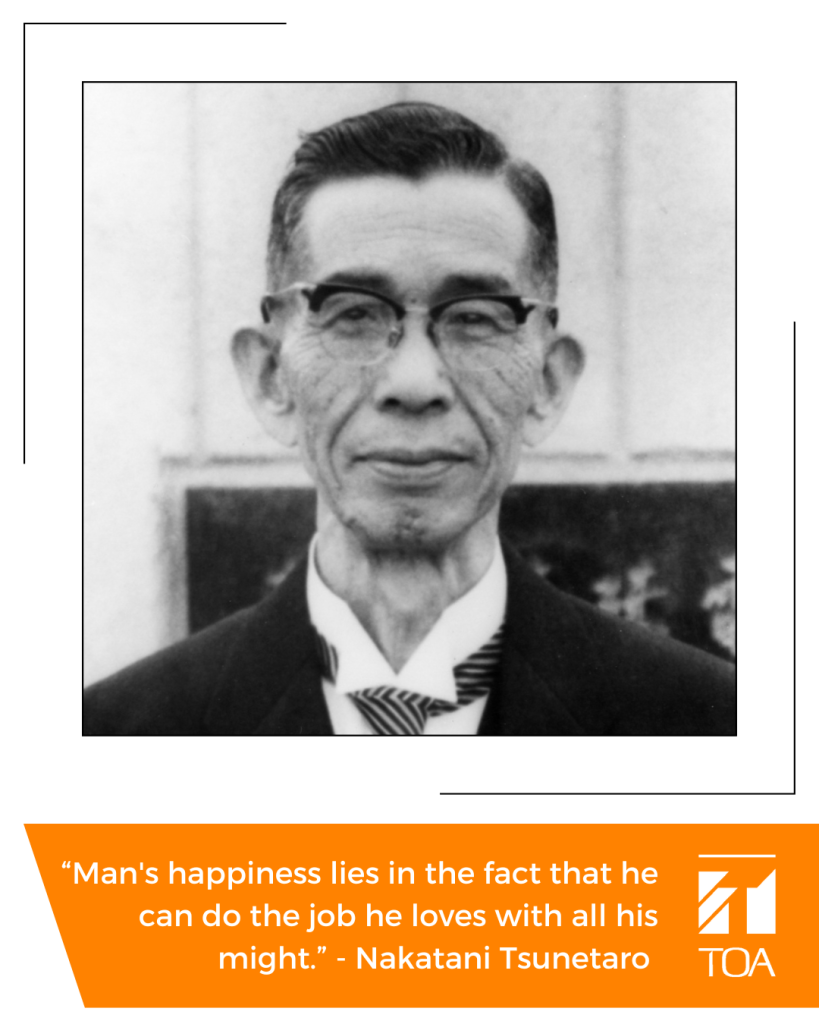 |
|
TOA Corporation was established in 1934, originally under the name "TOA Electric Manufacturing Co., Ltd.,". At that time, "T-O-A" ("tíː óʊ éɪ") was pronounced, “toɑ.” This portion of our name was formed by combining two Japanese Kanji: 東 ('to) – East, and 亜 (ɑ) – Asia, since Japan is located far east Asia, many Japanese companies used to use “toɑ” as part of their company’s names. This would mean that our company’s original name was “East Asia Electric Manufacturing Co., Ltd.” When we switched names in the late 80s to "TOA Corporation” the official pronunciation switched from “toɑ” to the "T-O-A" ("tíː óʊ éɪ") pronunciation that we’re all used to. A way to pay homage to the company’s roots, but also carry on a naming tradition that has since lost popularity in Japan. |
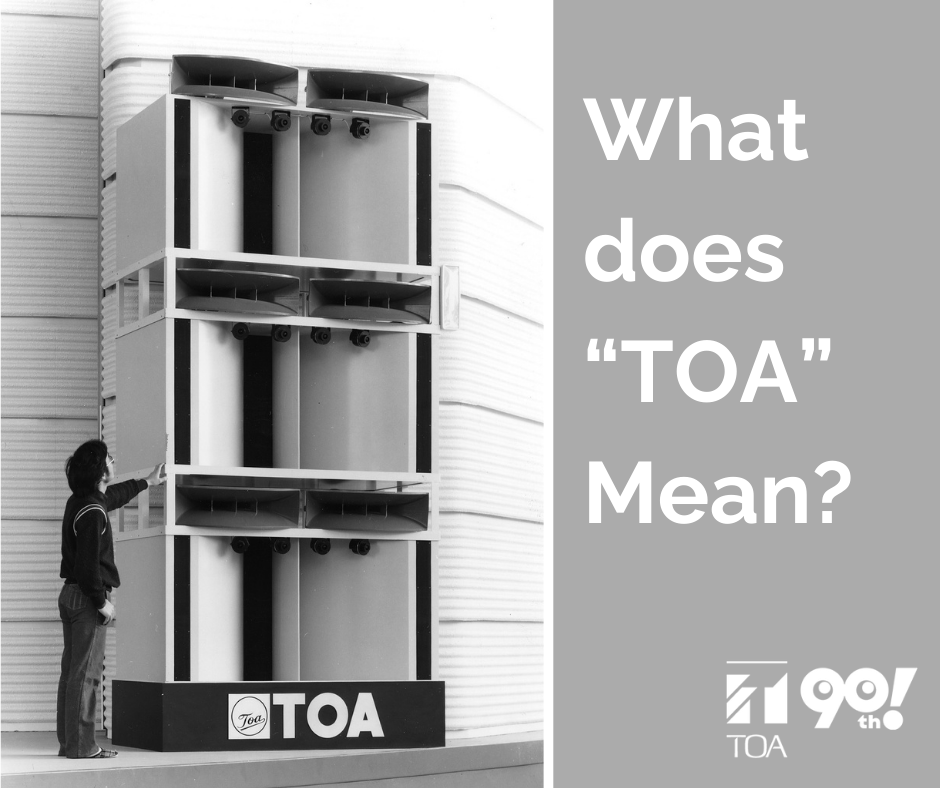 |
|
So is it TOA or T-O-A? A question that we've gotten quite a few times, the answer is a bit more nuanced than one or the other... TOA Canada is one of the Corporation's younger subsidaries and as such we've always presented ourselves as T-O-A Additionally, at least for HQ many of TOA’s customers have stuck to the original name, as they are more familiar with the "toɑ" sound rather than “T-O-A.” Unlike here at TCC, many over in Japan still call us "toɑ" even today, out of memory if nothing else. |
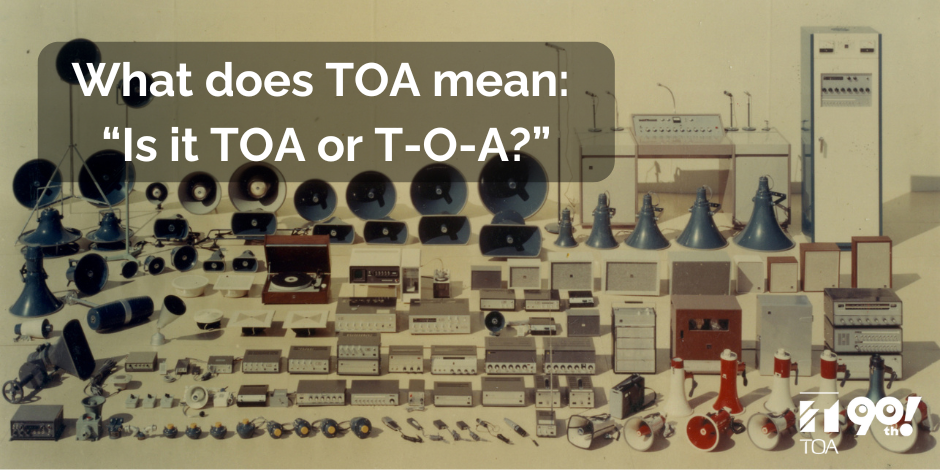 |
|
In addition to helping make the medicine go down, sugar also served a pivotal role in the early days of TOA. Some of TOA first products included carbon microphones, which utilized the carbon created by applying extreme heat to sugar. The sugar would first be liqufied and subsequently burned in a copper pot, with this sugar increasing in viscosity until it turns into a blackened cake. Then placed in a crucible pre-heated to 500°C, oxygen supply would be cut off, and the sugar would be continually heated until it hit 1,100°C before being rapidly cooled. The result is carbon in the form of coke, that would then be ground into evenly sized granules to be used in the mics. |
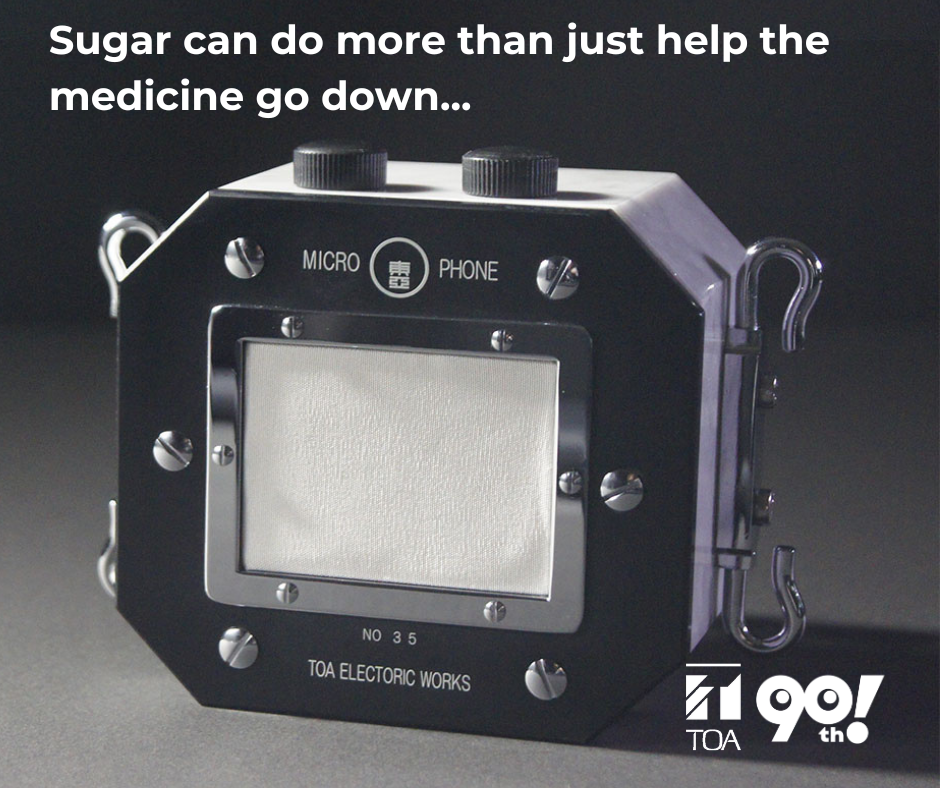 |
|
In our early days, we focused on some unique (and very descriptively named) products such as the "TOA Portable Amplifier” or TOA's “Record Recorder." Whilst both were well received and viable in their own regard, it would be the former of the two products that would shape the company's future. As we would continue in a similar vein with made-to-order rack-mount amplifiers, who mainly found their home in schools and factories. Through this, TOA gradually established its position as a specialized PA equipment manufacturer. |
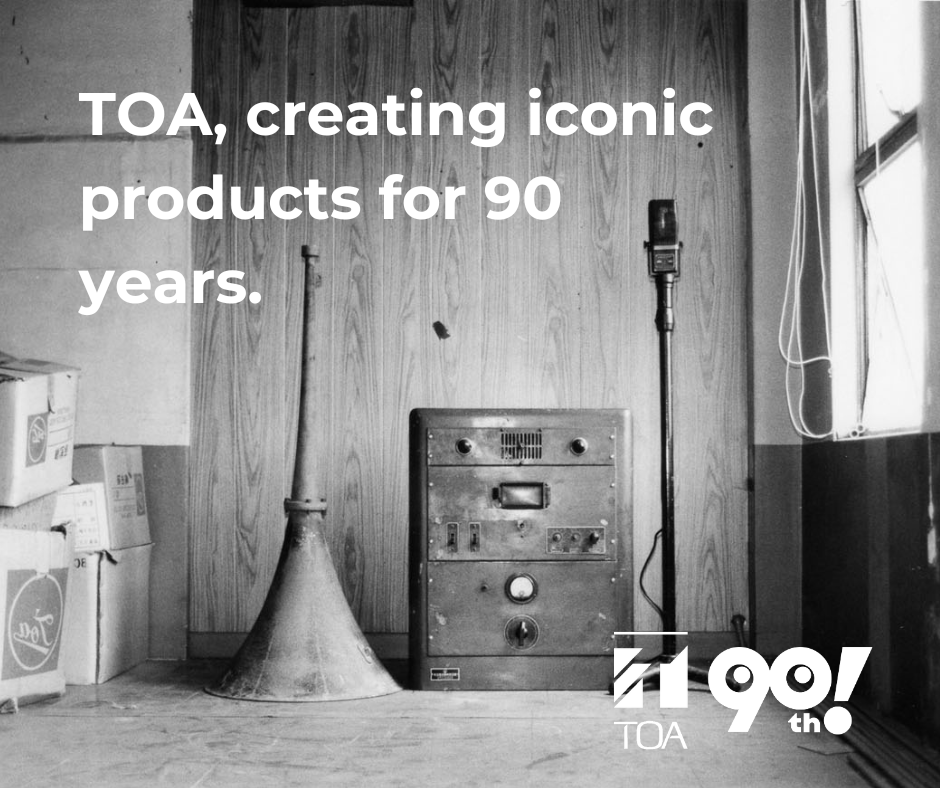 |
|
"Every tide has its ebb. Even strong business enterprises must obey this very fundamental rule of life. Therefore, we must strive with every action to preserve our company and protect it from unfortunate outcomes." This is the same mentality led to the creation of TOA's "Three Confidences," these policies have served as the benchmark for how we aim to present ourselves and our products to the world for nearly as long as the company has existed, and it is the very same policies that remain as a fundamental guide of our company to this day. |
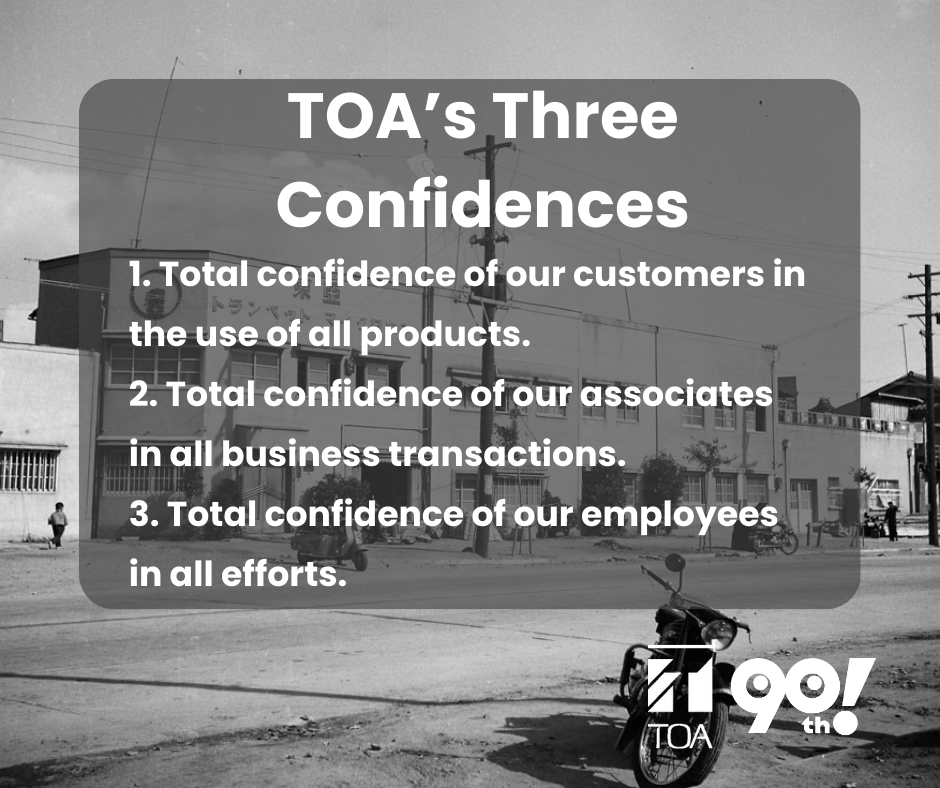 |
|
In 1954 TOA developed the first commercially available electric megaphone in Japan. Offering clear sound over long distances, ER-57's convenient portable design allowed the user to hold the microphone in one hand while hanging the speaker portion over the shoulder, and this earned it favorable reviews among political candidates campaigning in the streets. These products took advantage of the advanced technology of the day, and surprised the world with their lightweight, compact design, low energy consumption, and high performance. |
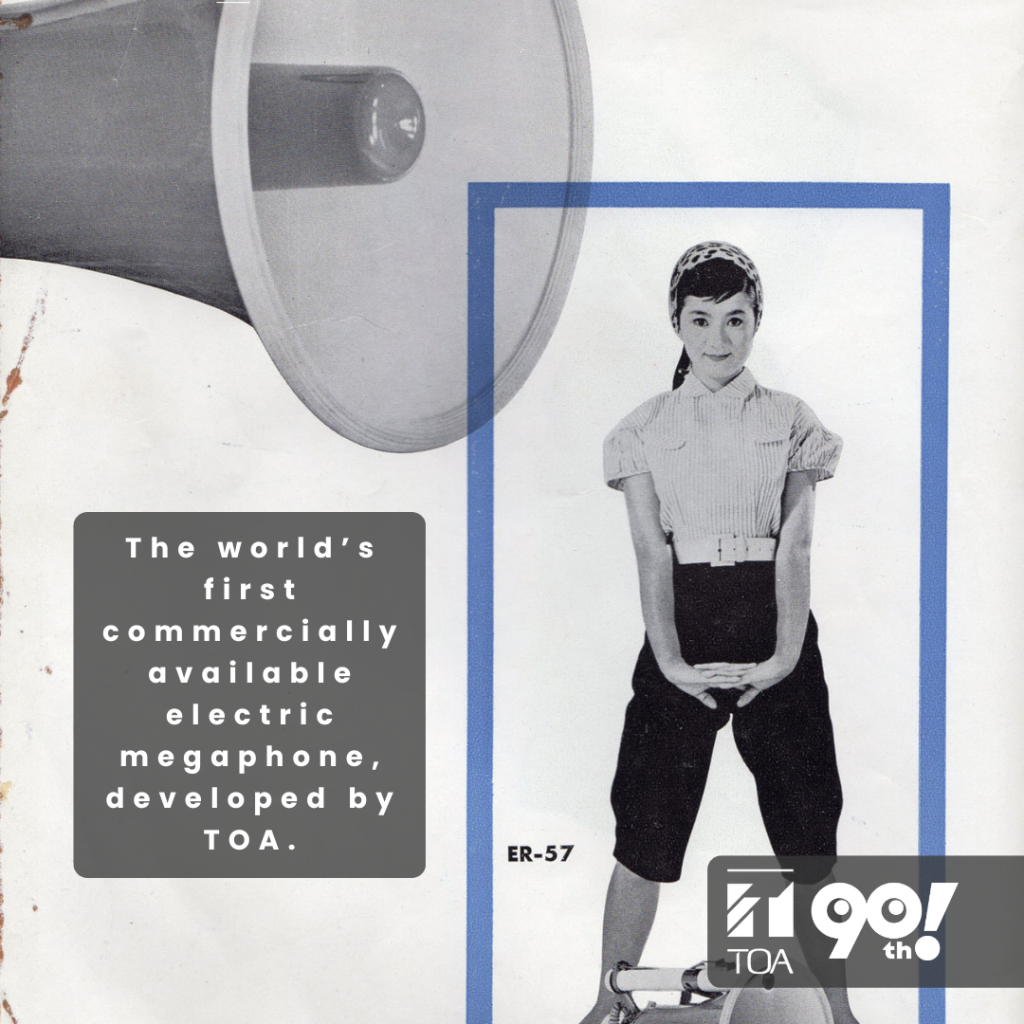 |
| Jumping forward in time ever so slightly, we wanted to highlight just how much can change in just several decades. Pictured is a super-large PA system developed in the early 60s. The system was a full 6.6m in total length and 3m in horn diameter. The system's furthest audible distance was 12km. | 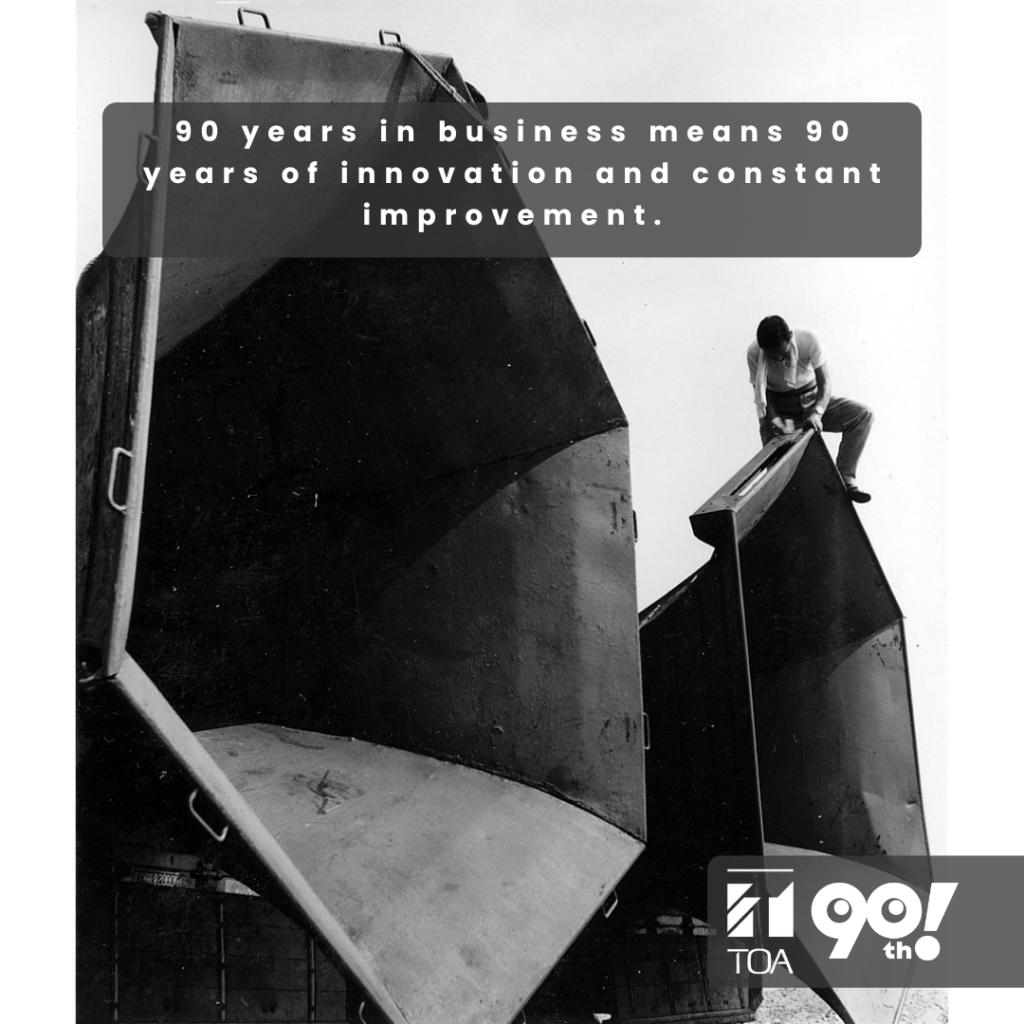 |
|
Highlighted in one of our previous history posts was the 6.6m super-large PA system, one of many products that was developed and tested for the mass notification and safety. We've got quite the varied history of delivering quality sound when its needed most, whether it was horn speakers as massive as these, or conversely speakers as small as the systems mounted on police motorcycles to ensure officers had mobile systems to deliver announcements. For 90 years, TOA's been making neighbourhoods safer one speaker at a time. |
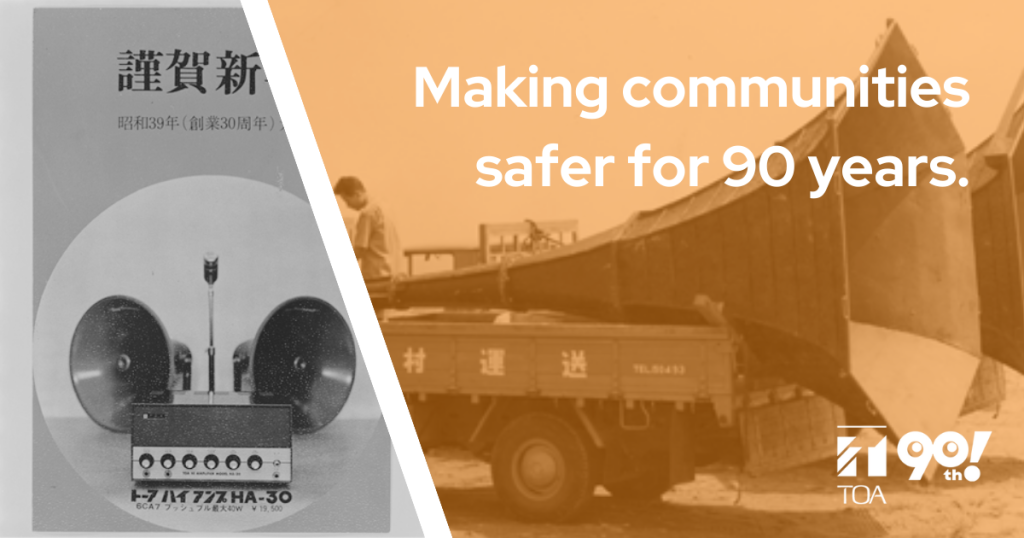 |
|
Being hosted in TOA's home country of Japan, the 1964 Olympics served as an opportunity for TOA to display it's prowess to a global audience. The Tokyo Olympics organizers employed TOA via contributing “sound” support in the form of broadcast equipment. Our systems could be found throughout the games, as products were incorporated into almost all of the Olympic venues that year such as the horn speakers shown here! We were and still are extremely proud to be able to be part of such a monumentous event! |
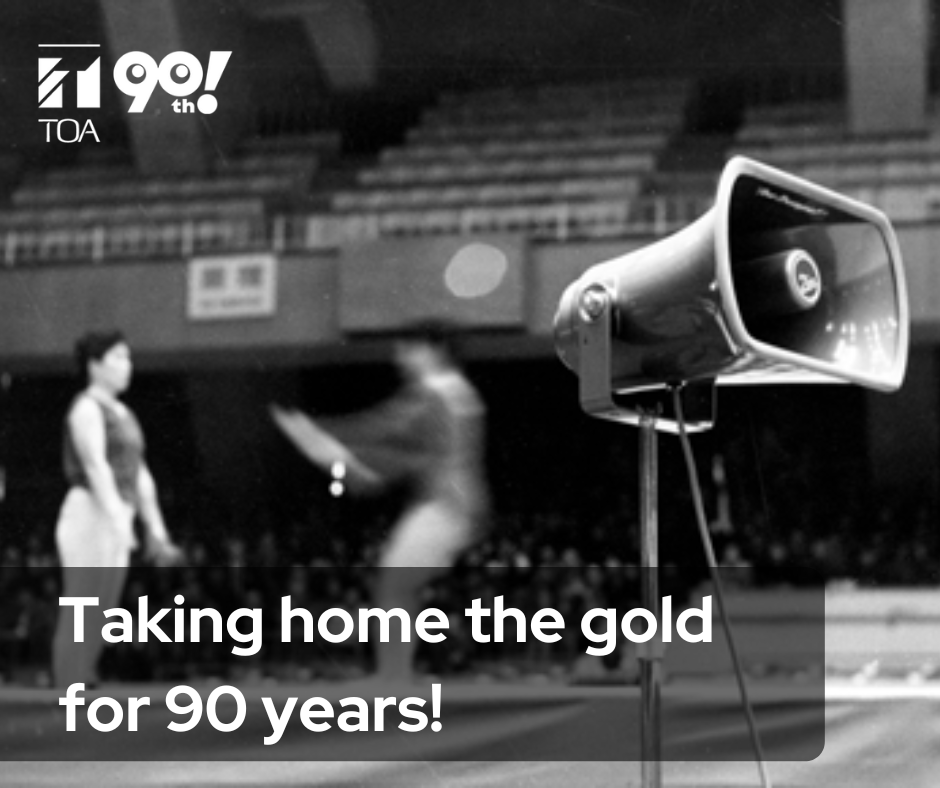 |
| Held in the the Senri Hills in Osaka, the 1970 Japan World Exposition was the first-ever international exposition held in Asia. TOA was chosen as a supplier for a variety of sound equipment due to our already-storied history as a specialized PA manufacturer. Over 70 nations participated in this exposition, all being able to experience elevated "hospitality through sound" whether it was through the pavilion PA systems, automatic broadcasts on the monorail, or even the “radio cars” traversing the grounds. | 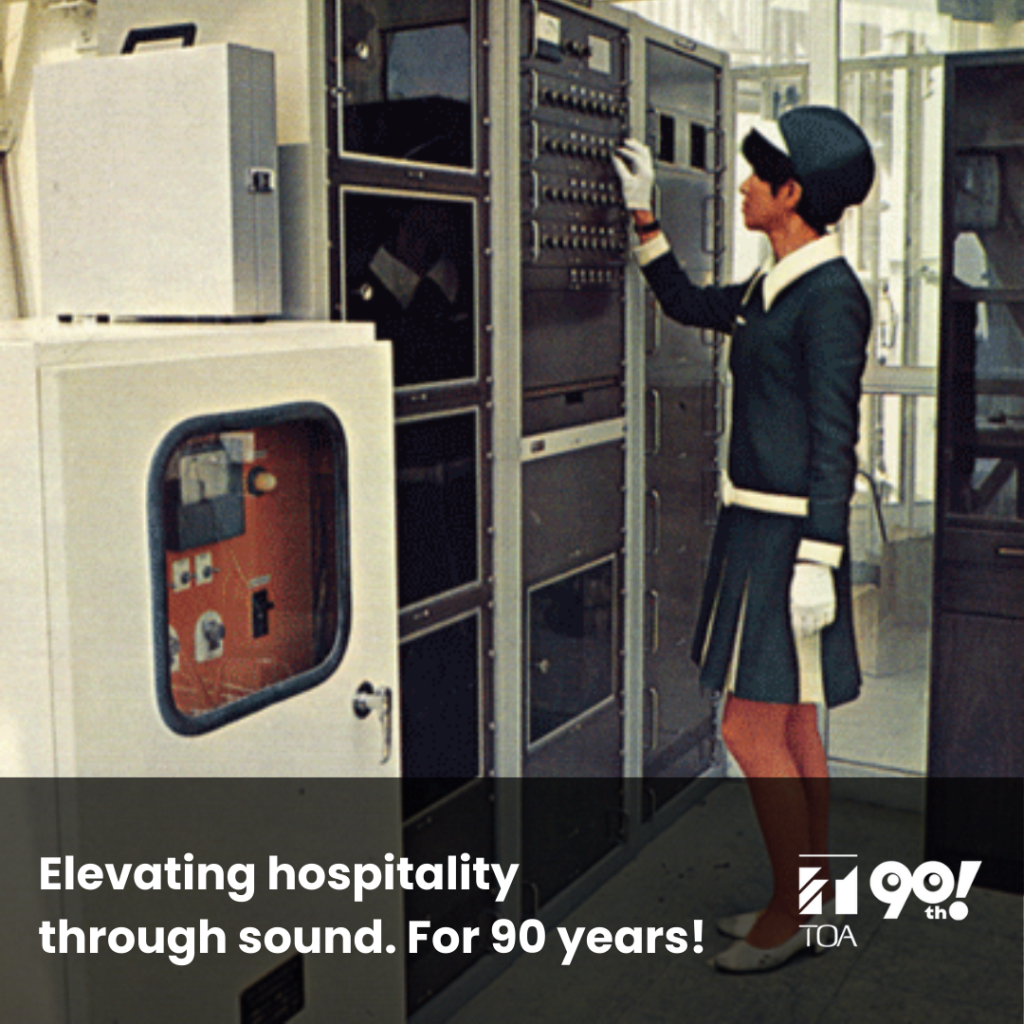 |
|
In the early 70s, TOA designers resided in San Francisco, California to conduct research on how best to innovate within the world of pro AV products. As a result of extensive market surveys, we decided that we should start planning a new product, and visited every company we could find that was related to acoustic sound. Our development theme at the time was to create something new, "Something Different." "We believe that it is important for the manufacturer's thinking or fundamental policy to be visible in the product itself. Of course, making products that ultimately satisfy customers is the most important goal of all." |
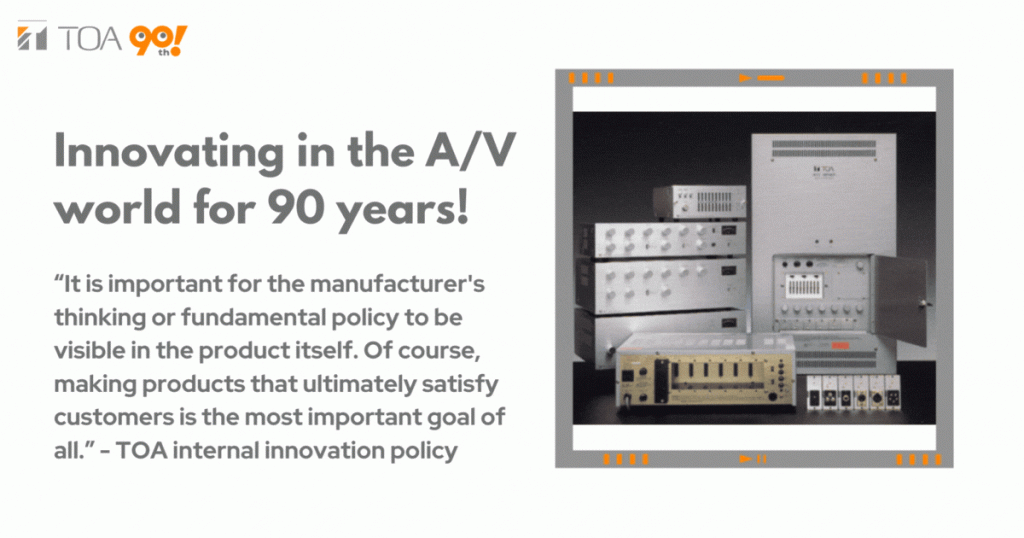 |
|
TOA helps ensure that travellers and commuters get from A to B: With installations in Narita and Wakayama station(1971 -1972), as well as Namba Station(1975)—the largest station on the Nankai Line—these pivotal projects help solidify TOA's position as a leader in sound equipment for the transportation infrastructure market. The automated guidance broadcast systems as well as audio file technology used in such systems soonafter began being soon being incorporated into numerous other railways and airports. In short, one of the most punctual countries in the world ensured that passengers arrive on time with TOA! |
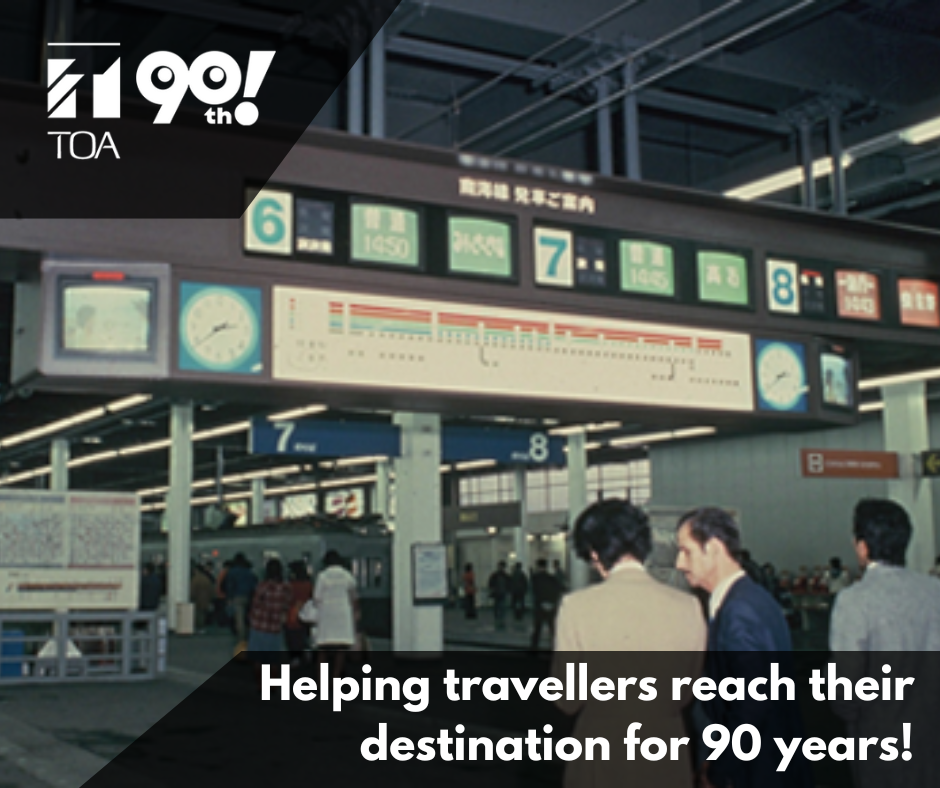 |
|
In the mid 1970s, TOA Corporation had started a joint company in Jakarta, with the goal of developing a bastion for localized production overseas. As a byproduct, this served as TOA's introduction to international production efforts! Fast-forwarding a few decades, TOA Corporation now has 27 sales and production bases located across the globe, ensuring that people all over the world can experience crisp, clear, high-quality sound! |
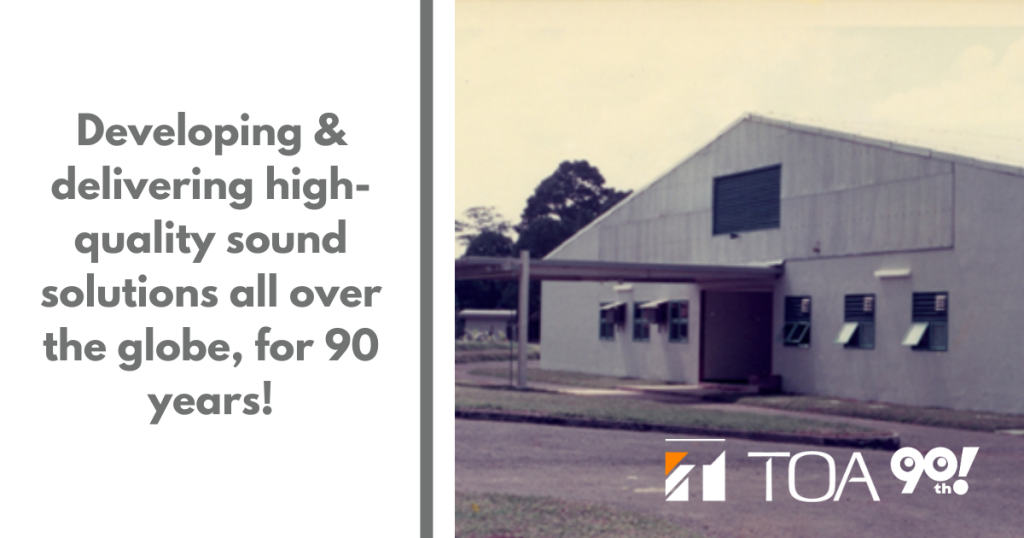 |
|
Did you know that TOA had a major hand in the Japanese Karaoke boom? Much like TOA Corporation itself, karaoke too originated in Kobe. Familiar to most would be the dedicated spaces in Japan known as "Karaoke boxes" that began popping up in the mid-80s, but before these dedicated spaces, a portable solution was required to empower a growing love of karaoke. Enter TOA’s MA-007 wireless music amplifier, a portable solution for karaoke performance that proved to be a major hit. It wasn’t long before a karaoke craze swept over Japan, and in the five years between the launch of the MA-007 and the development of karaoke boxes, TOA developed an even broader product lineup ranging from commercial to home-use equipment so that the joys of karaoke could be shared across Japan! |
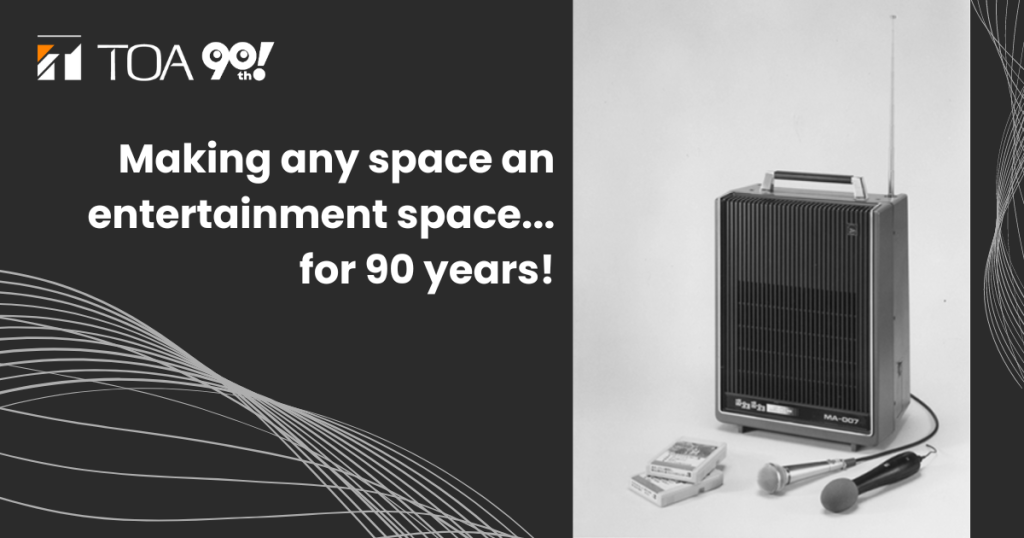 |
|
Nestled in the 1980s was one of the most impactful moments in TOA's 90 year history that is still visible today! Adopted in September of 1984 —exactly 50 years from the birth of the company itself— we transitioned over into the logo that you all know today! With this shift came the reinvigoration of our values, as the four corners of icon represent our four cornerstones of business: These core values are what have allowed us to bring smiles to the public, through not only satisfying, but also reliable, reassuring, and emotive sound. For 90 Years! |
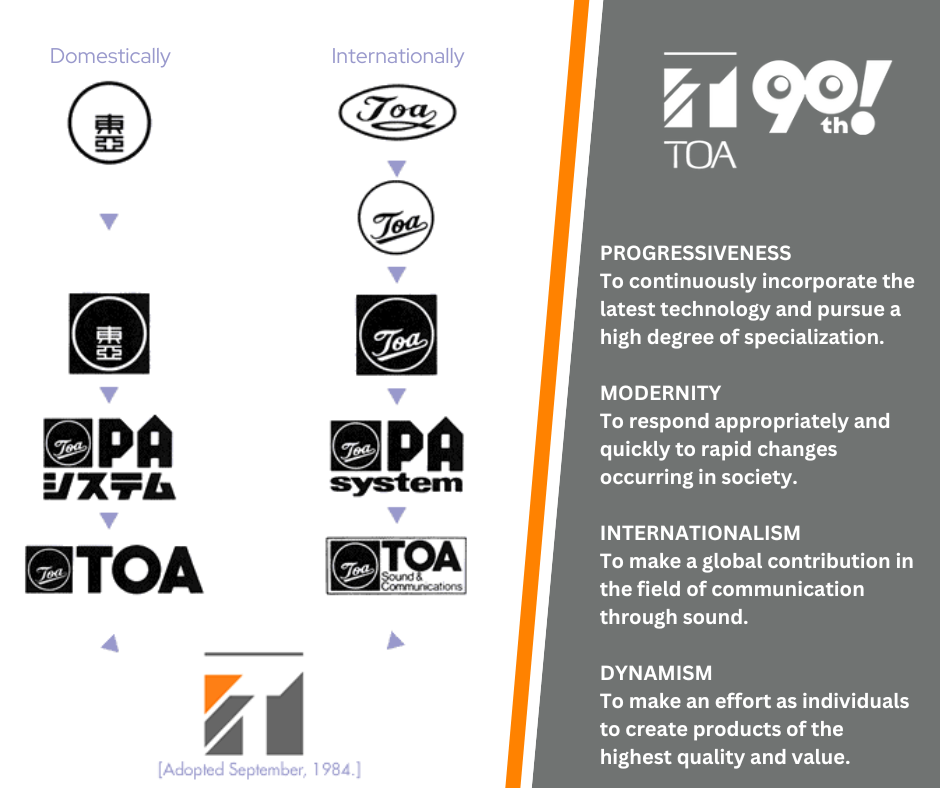 |
| In the latter half of the 1980s, Japan saw the opening of numerous small live music venues and discos, applications that required sound systems durable enough to pump out high-volume sound reliably over long periods. Also during this time, even more commercial and amusement spaces globally began desiring bespoke audio designs for their spaces, and through this many clients appreciated TOA’s active approach and dedication towards sound creation. These formative years further solidified TOA's place as a devoted large-scale sound solutions provider. | 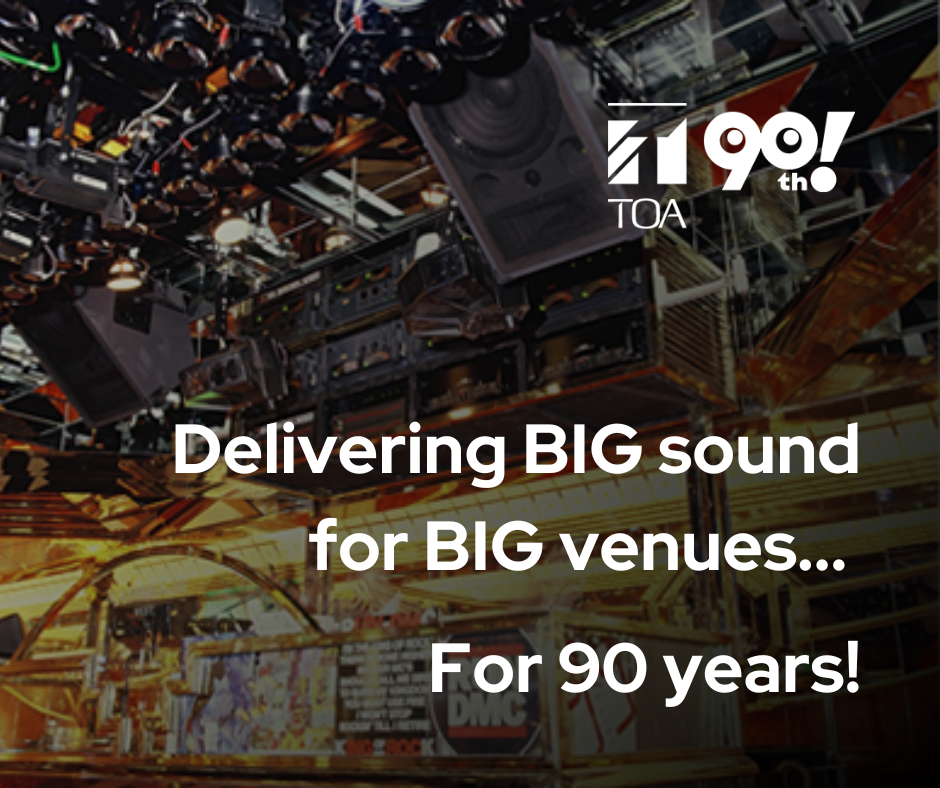 |
| Following TOA's reinvigoration symbolized by the adoption of our modern icon, the 80's also saw us take much more physical steps to signify this next chapter of TOA. In the late Spring of 1989, construction of our new headquarters on Port Island in Kobe was completed. At this time we also revised our name, changing from the original “TOA Electric Co., Ltd.” to the more modern-sounding “TOA Corporation.” As Japan embodied modernization in their new “Heisei” era, so did TOA. | 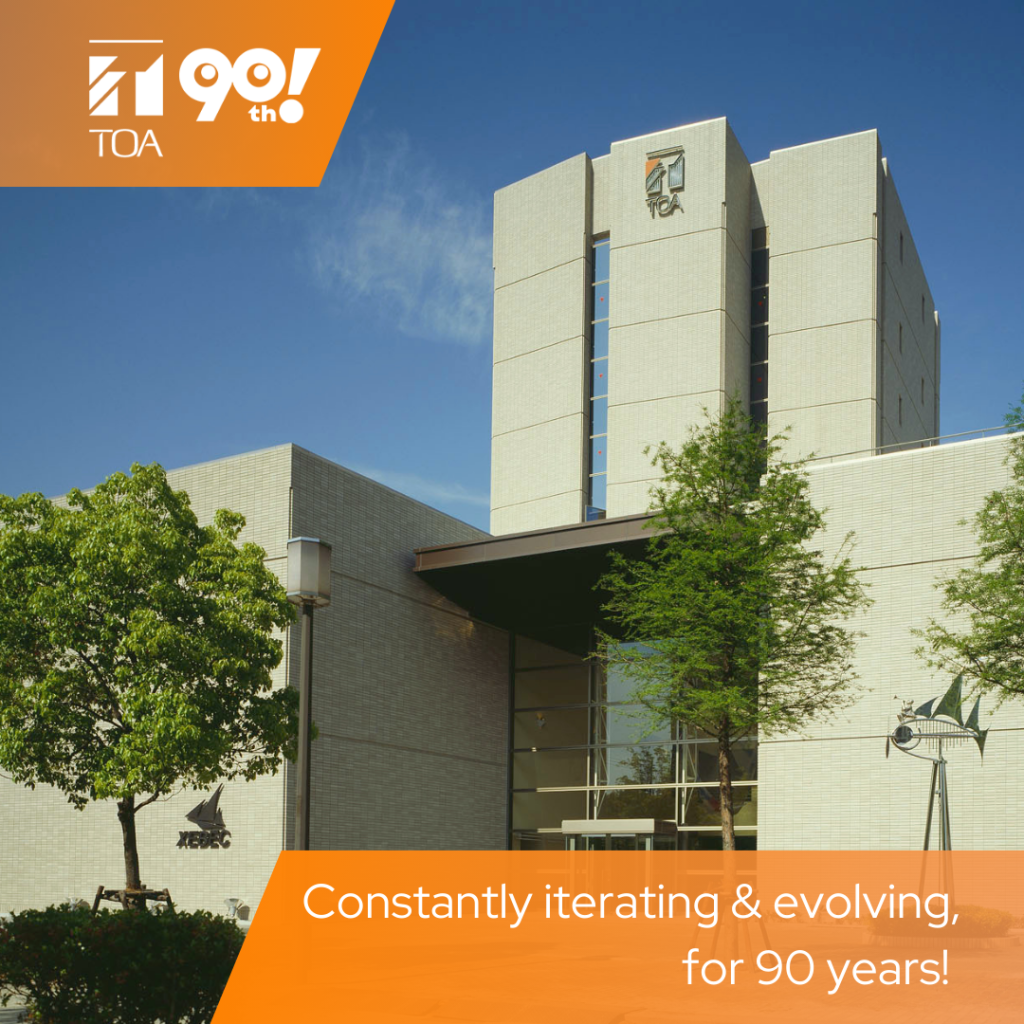 |
|
While we may be a bit biased, this is definitely one of our favourite moments in the history of TOA Corporation to this point! Established in 1990, TOA Canada Corporation has served as the Canadian branch of TOA, delivering high-quality sound all across Canada for over 30 years! With our teams stationed across Canada, we ensure that Canadians in all provinces and territories all have devoted sound experts ready and capable of connecting you with your newest sound solution. A little-known fact, while 1990 would mark the official start for TOA Canada, at this point TOA had already made its mark on the Canadian market. This was achieved through multiple TOA satellite offices located in Alberta and Ontario, and served as the precursor to TOA Canada Corporation itself. |
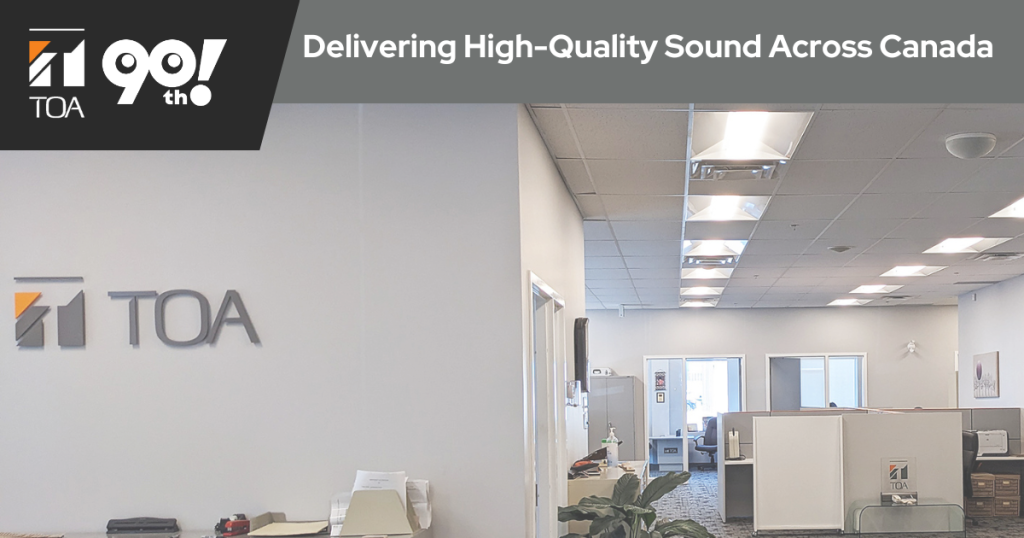 |
|
TOA wouldn't be where it is without the audio experts who have propelled this company forward for nearly a century. We want to take a moment to express gratitude towards team members of TOA across the globe, past, present, and future! Pictured here is the ix-9000—a system that would later be installed in the Vienna National Opera Theater—along with a short excerpt from one of the development engineers who was pivotal in the system's creation. |
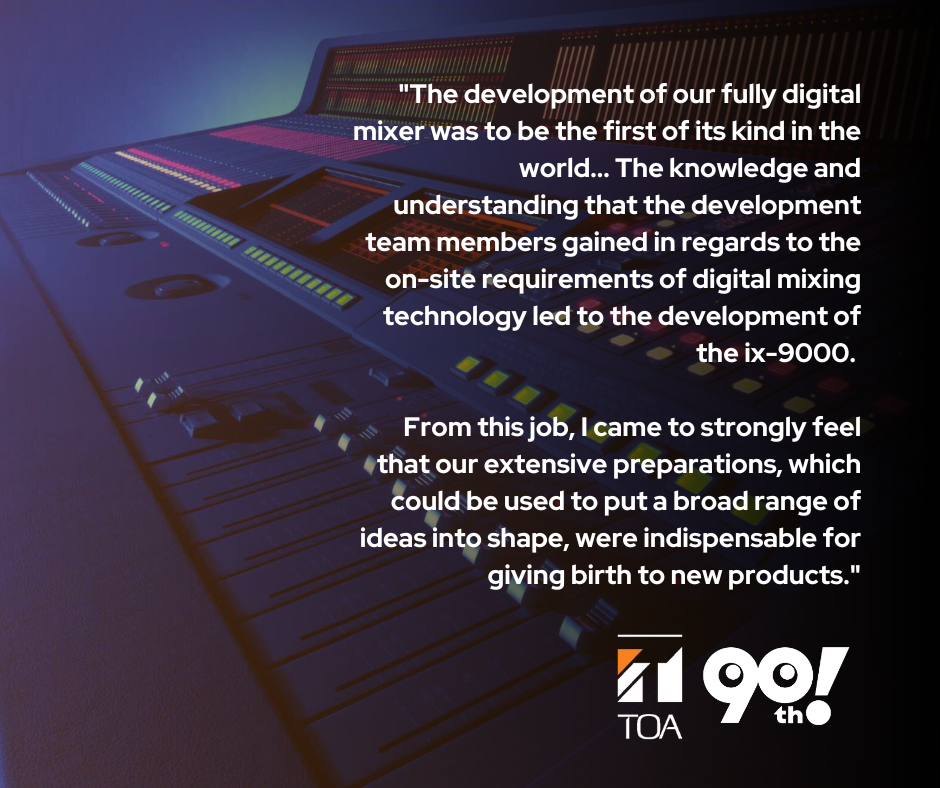 |
| We're once again looking at how music and events have played a pivotal role in the life of TOA to this point. In the early 90's, TOA released its Z-DRIVE touring speakers. This was developed through an initiative set in place nearly a decade earlier, where a special team was formed and tasked with investigating the needs of musicians and sound engineers. These speakers were developed around the foundational components of sustaining persistent hard-use, and TOA's standards for durability with high quality sound deliverance. They performed better than we could've even dreamed when the special department was formed, and found success in many live music venues and outdoor events. |
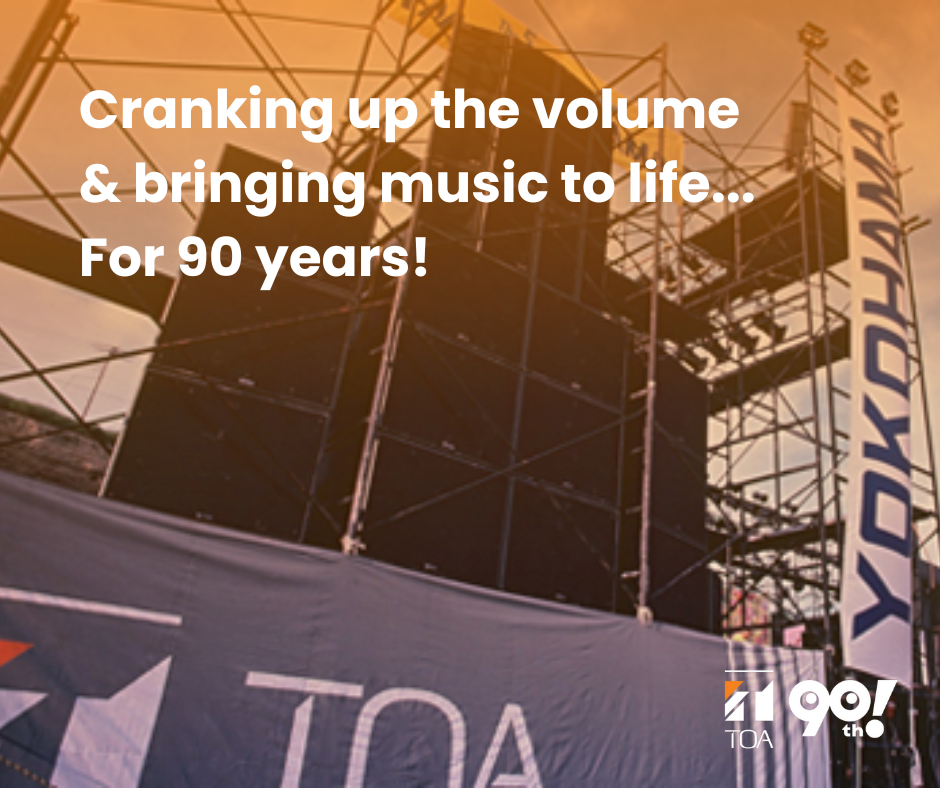 |
|
In 1995, TOA received the Grand Mecenat Award (sponsored by the Association for Corporate Support of the Arts), was presented to TOA corporation for our support of the arts and culture. While promoting good experiences through sound is something that we are always trying to share, TOA received this award for its highly regarded "sound culture enlightenment activities," as promoted through its XEBEC Hall public performance base. And TOA intends to continue this style of activities to share the joys of sound! We see great importance in the relationship between individuals and the surrounding environment, and the ideal role that sound plays in that environment. |
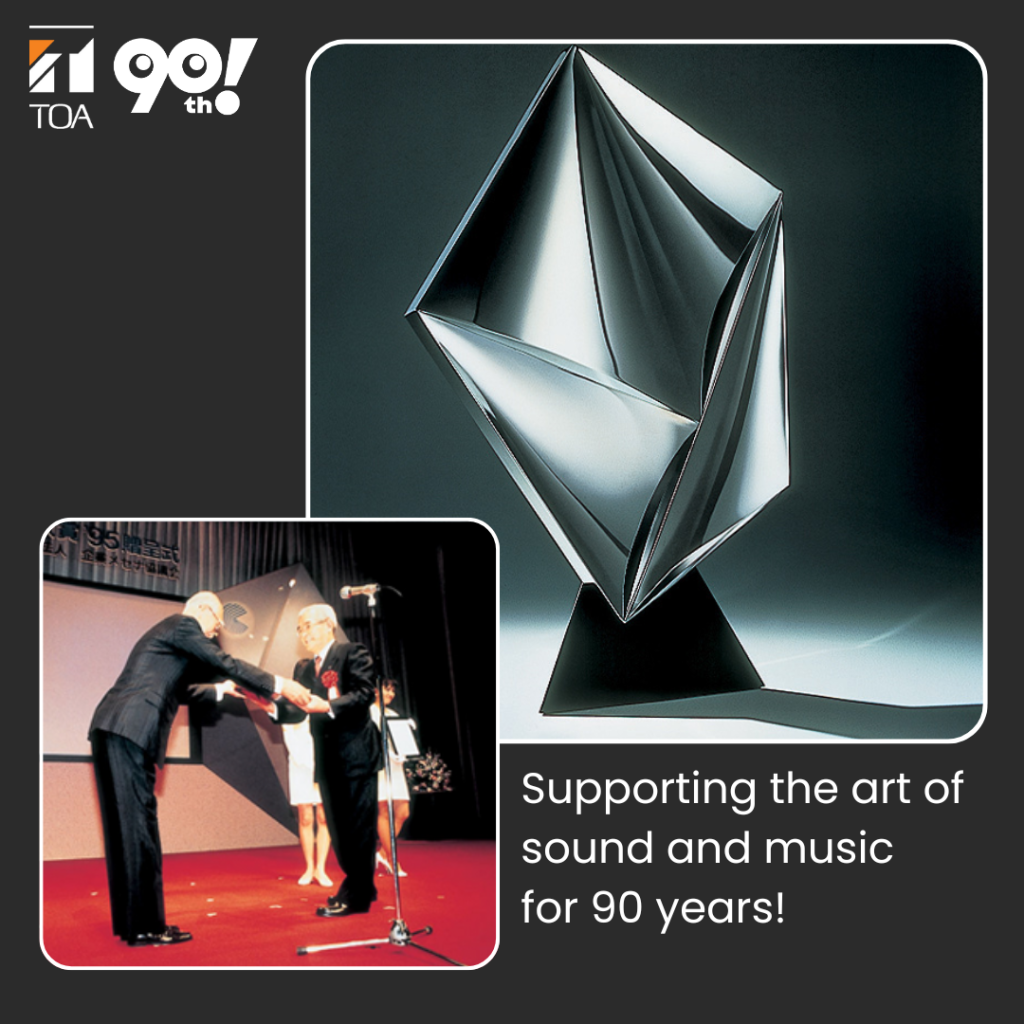 |
|
A portion of our history that we still happily carry forward into the future, every year since 1995 TOA Corporation has assisted in creating enjoyable experiences within each and every Kobe Luminaire Light Festival. Serving as a commemoration for the victims of the Great Hanshin Earthquake, this festival embraces themes of recovery and high hopes for the city’s future.” As a regionally aligned company with strong roots in Kobe, we've been doing what we do best, producing the music that matches each year’s illumination theme and also by providing the sound systems for the event to elevate visitor experiences through sound. |
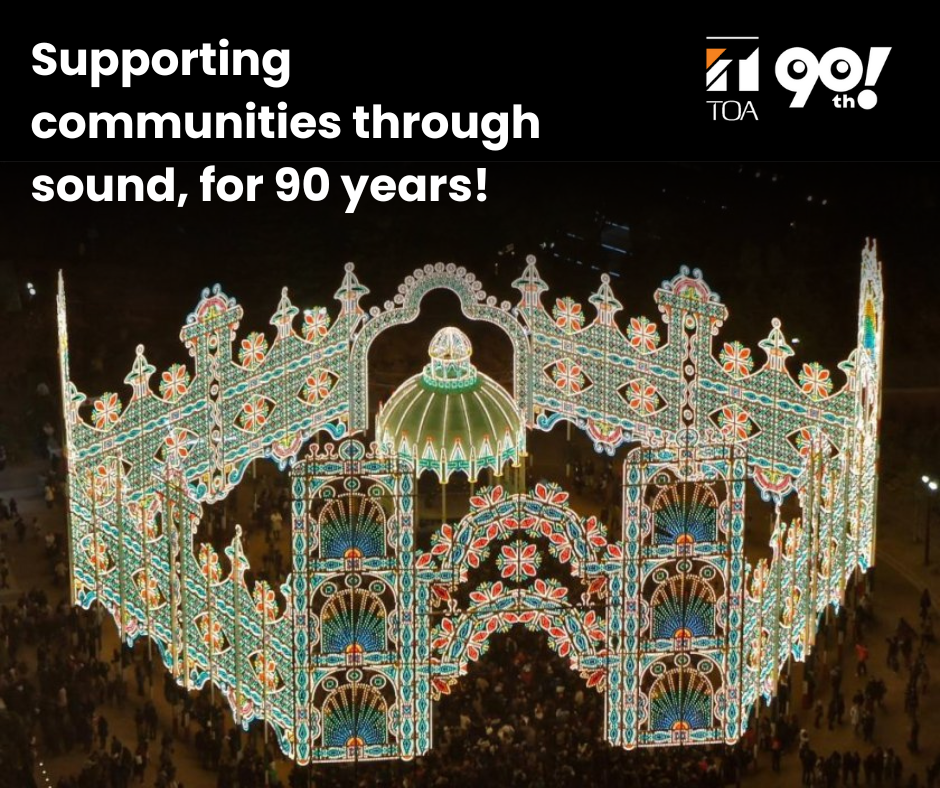 |
|
Just before the turn of the millennia, TOA's celebrated the completion of our new Takarazuka Operations Building. In April of 1998, we opened the doors officially to this newest extension of our efforts to constantly push the boundaries of what can be done through sound. With the grand opening of this new building, we were able to further reinforce our commitment to being the pinnacle of what it means to deliver experiences through sound. Fitted with an immense integrated sound system, inhabitants are enveloped in sound, met with a custom-designed and curated soundtrack ranging from welcome sounds to elevator chimes and everything in between! |
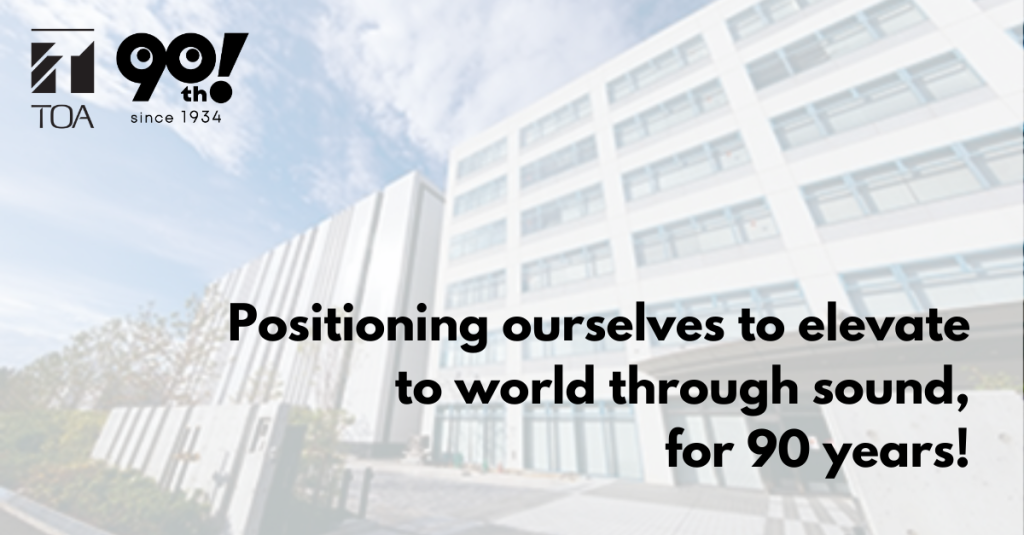 |
|
Developed just after the turn of the millennia, TOA’s “Super Streetlight System” was introduced by the Tokyo Metropolitan Police Department in Ginza in 2004, developed with the purpose of continuing to create a safer, more secure public space for all. These streetlights would serve as an opportunity for TOA to venture out of the realm of audio, focusing on community safety as a whole. The streetlights come equipped with dome-enclosed surveillance cameras, as well as a network connection to the local police station. Additionally they would be fitted with a one-button emergency connection to police for swift response in times of emergency. |
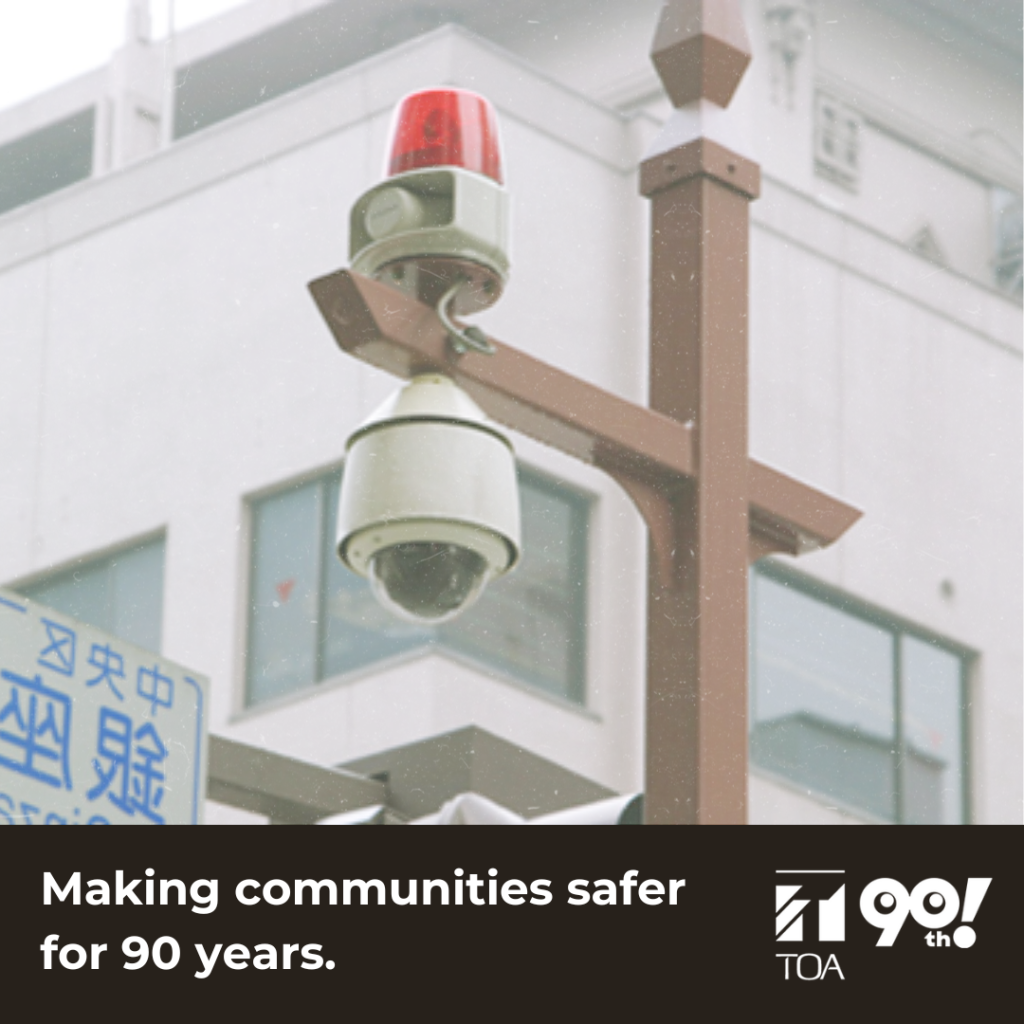 |
|
Constructed in the early-to-mid 2000s, for a time the Taipei 101 Building was the world’s tallest office building! This feat of engineering and architecture was designed and fitted with a TOA-built emergency and general-purpose public address system, designed to ensure the comfort and provide safety and security throughout the building. Targeted broadcasting functionality was essential given the sheer size of this building. With TOA, operators able to easily switch between targeting specific zones, and delivering messages and important emergency broadcasts to the entire building. |
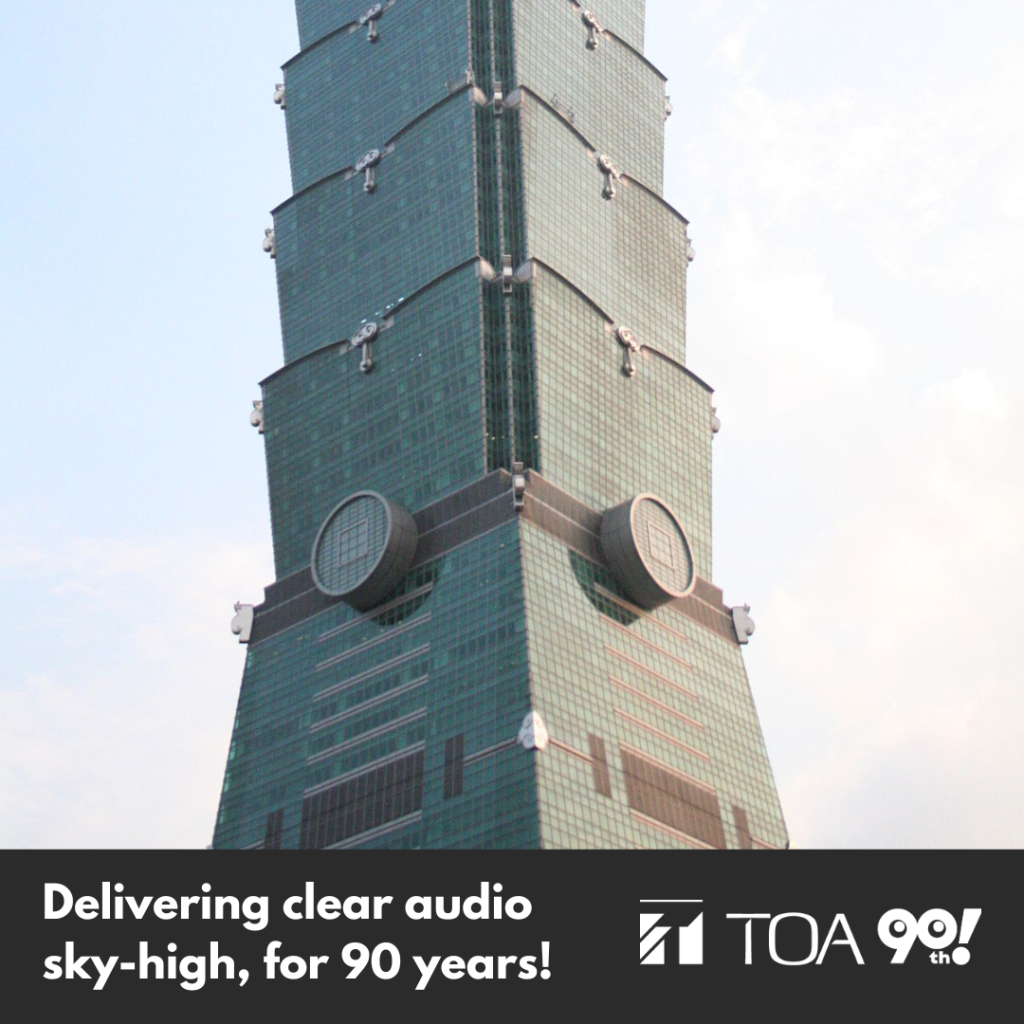 |
| Nearly a century after its initial construction in 1924, Japans first authentic Baseball Field Koshien Stadium in Kobe was set to be accelerated forward with a modern sound system. In 2010, this landmark venue underwent a major renewal, including the installation of new sound system featuring TOA line array speakers optimized for such a large-scale sports field. The stadium's new TOA solution served as a great way to kick off the 2010s, pumping up crowds with each and every match! | 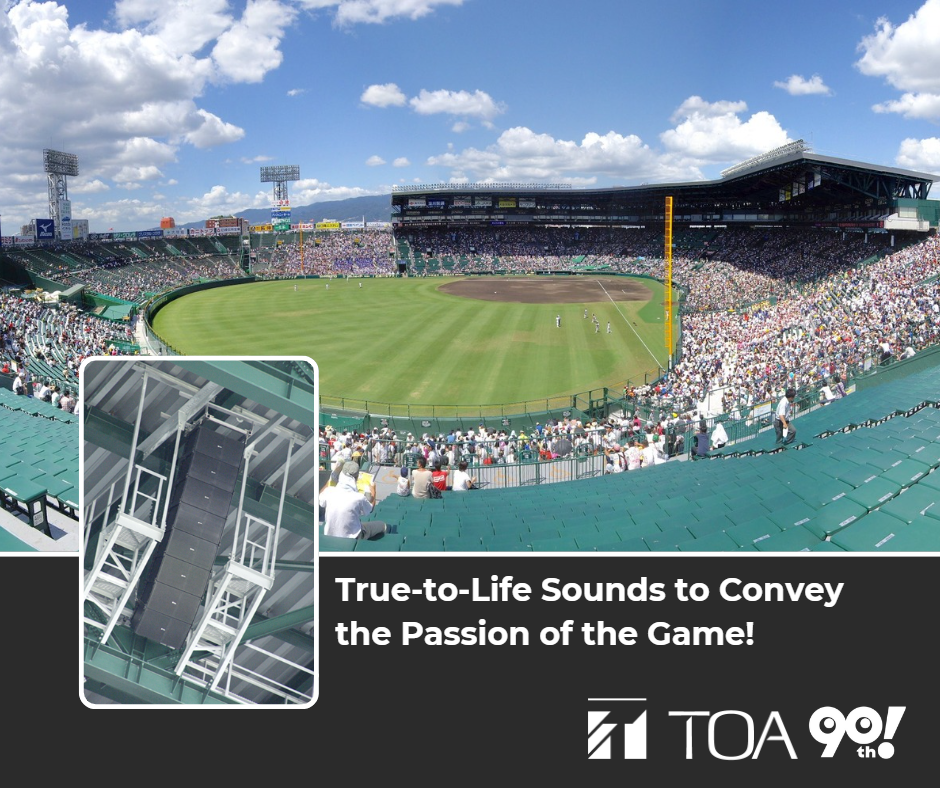 |
|
Continuing on the topic of upgrading sound systems within major sports stadiums, TOA also continues its retrospective on life so far with another notable stadium install... Hosting the Wimbledon Championships, the Wimbledon Tennis Courts are one of the most recognizable spaces for tennis across the globe. during a renewal of the public address systems here required updated, high-performance features. As such, in 2011 TOA installed a system that includes the SX-2000 Smart Matrix System along with digital power amplifiers, helping to ensure the safety and smooth progress of each and every match. |
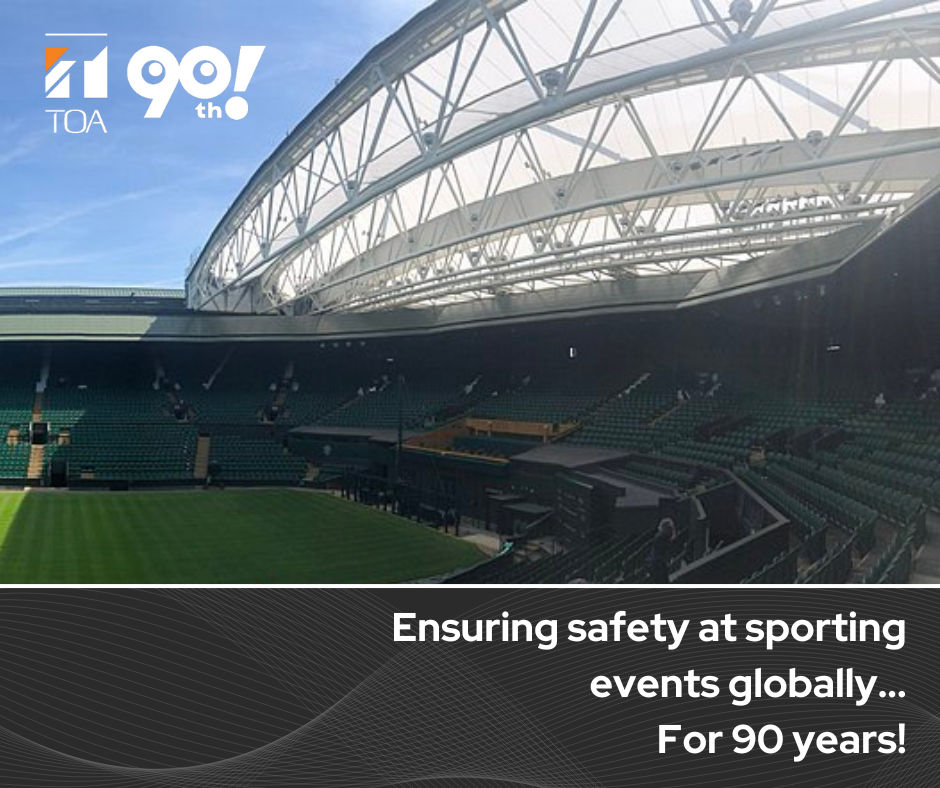 |
|
As we reach ever-closer to the present in our reflection of TOA Corporation's history and impact, we have the joy of being able to reflect on initiatives that we still have a hand in today! TOA Corporation has supported the Kobe Marathon since 2011. By providing speakers, megaphones, and various kinds of sound equipment to provide clean, clear sound that can be heard all the way from the start line to the last runners bringing up the rear nearly a kilometer away. And welcoming runners at the finish line too, TOA’s speakers pump up the action and excitement of the event by delivering encouragement, music, and real-time announcements to the spectators lining the course. |
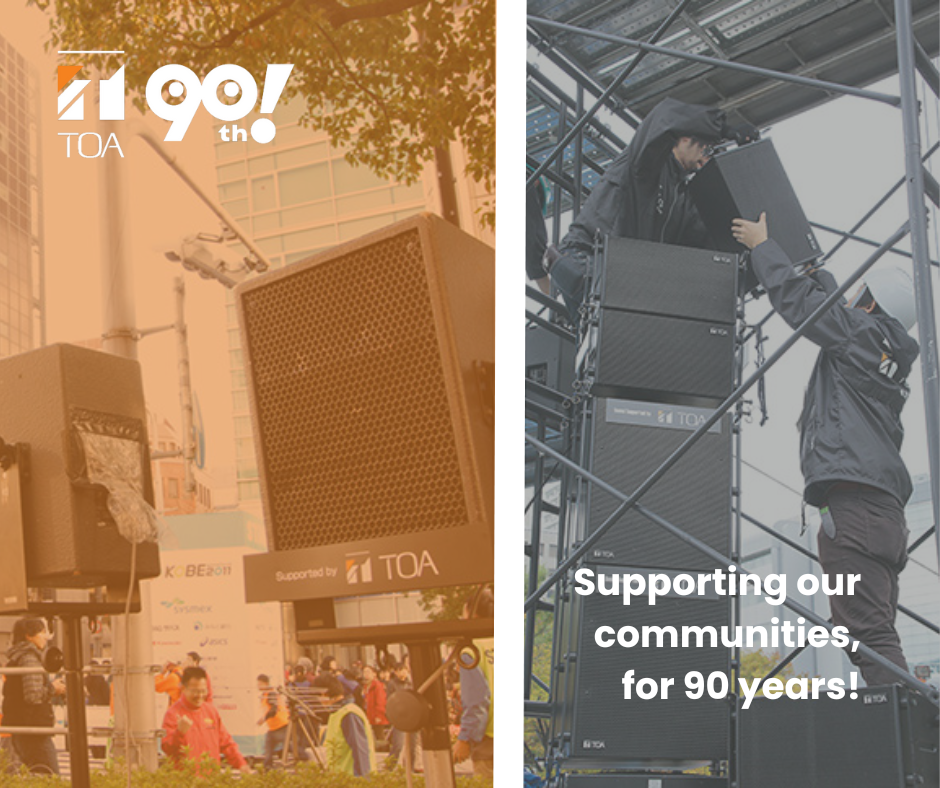 |
|
Disaster broadcasting speaker equipment is recognized as one of the most impactful categories of public address equipment. After the Great Tohoku Earthquake of March 11, 2011, this importance very quickly became all too familiar to many across Japan. As a Kobe-based company that experienced the Kobe-Awaji Earthquake, TOA remains dedicated to any efforts that will help prevent and minimize the effects of disasters on people. Horn array speakers can project sound about twice as far as conventional speakers, and because their sound can still be heard clearly, they make it possible to inform and direct persons located near and far to safety. |
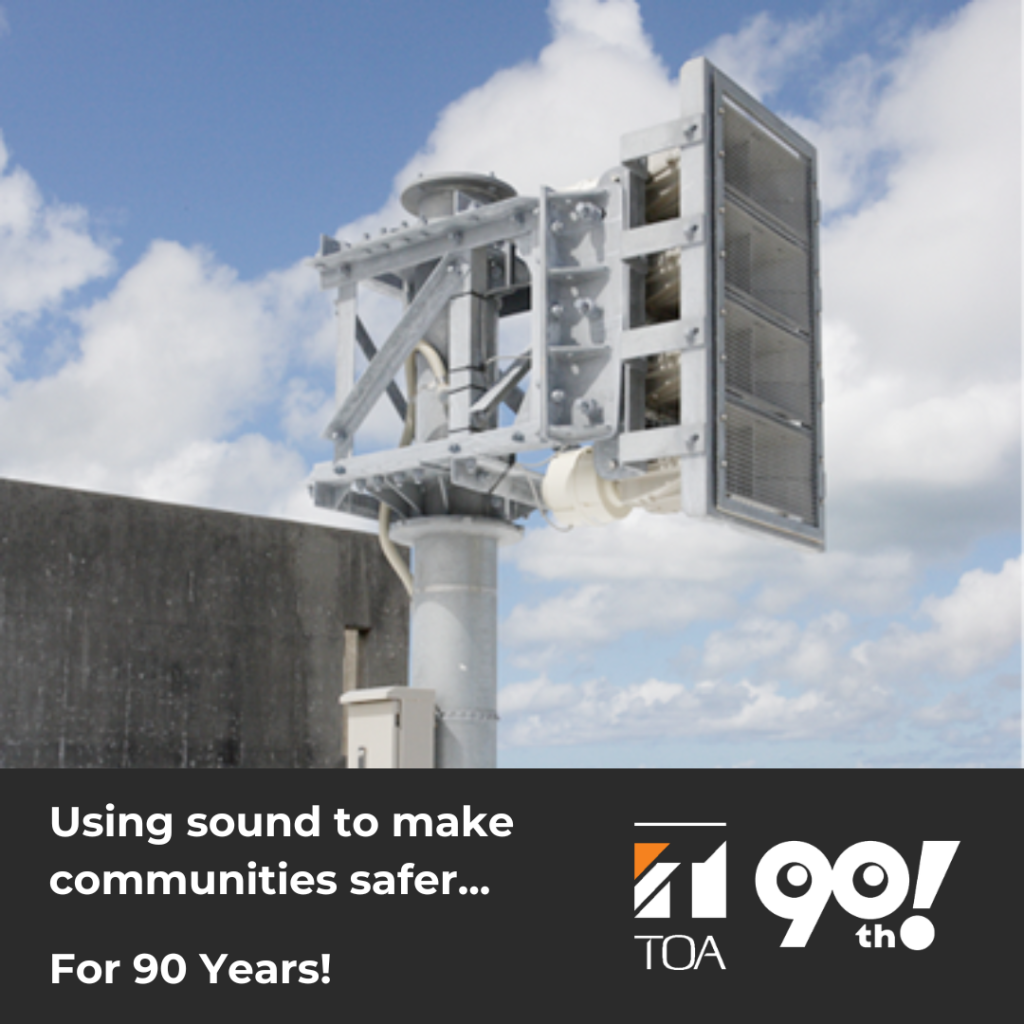 |
|
Capping off our 90 year retrospective and history, we look at the present day TOA as well as the aspirations we've set for the future! Newly renovated and opened in 2020, TOA’s Knowledge Square is our new business hub introduced with the redevelopment of the Takarazuka R&D Center, TOA’s base of research and development. This location was designed as a place where various individuals—including in-house developers, users, business partners, partner companies, universities, and research institutes—as well as information can be brought together to create new value. The R&D Center is also home to TOA Mirai Solutions, TOA’s future-oriented technological development and center for collaboration. |
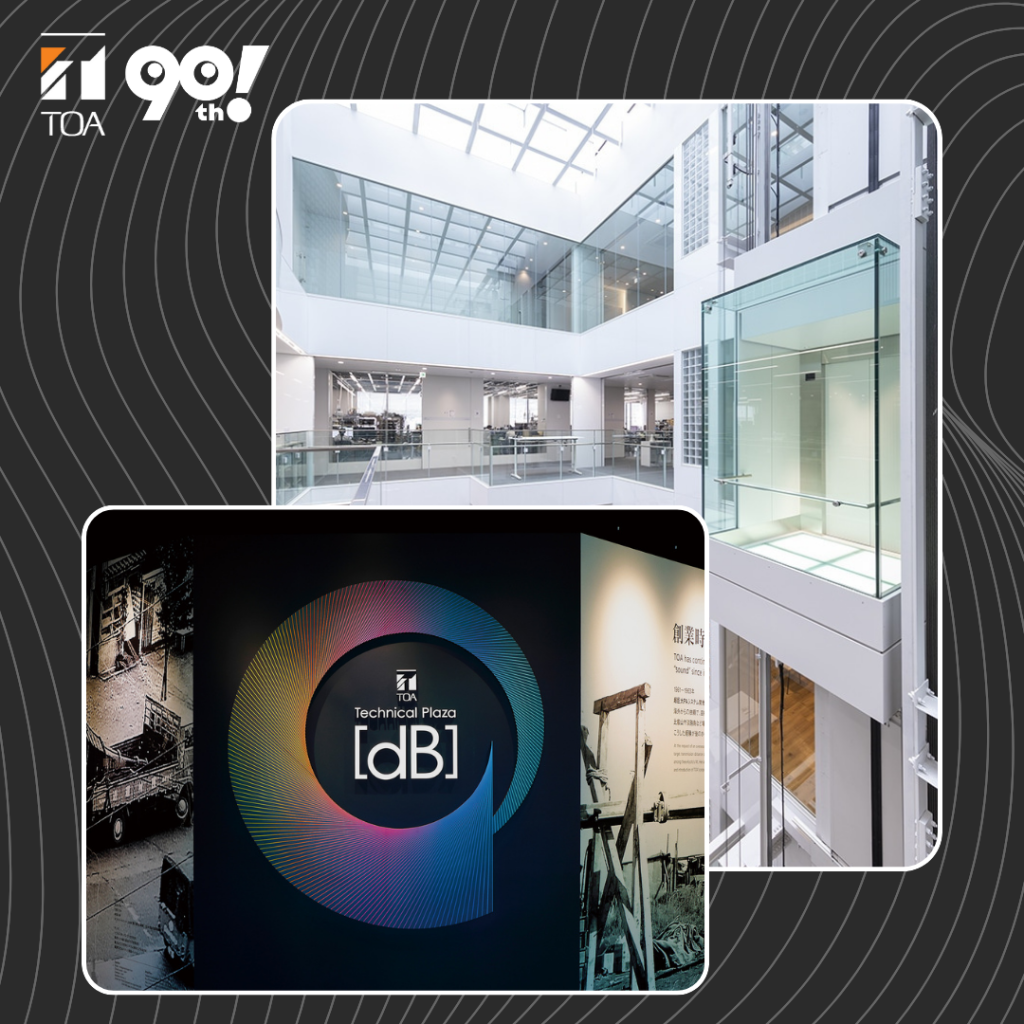 |
- News
TOA Turns 90; A Retrospective On What Led To The TOA You Know Today
